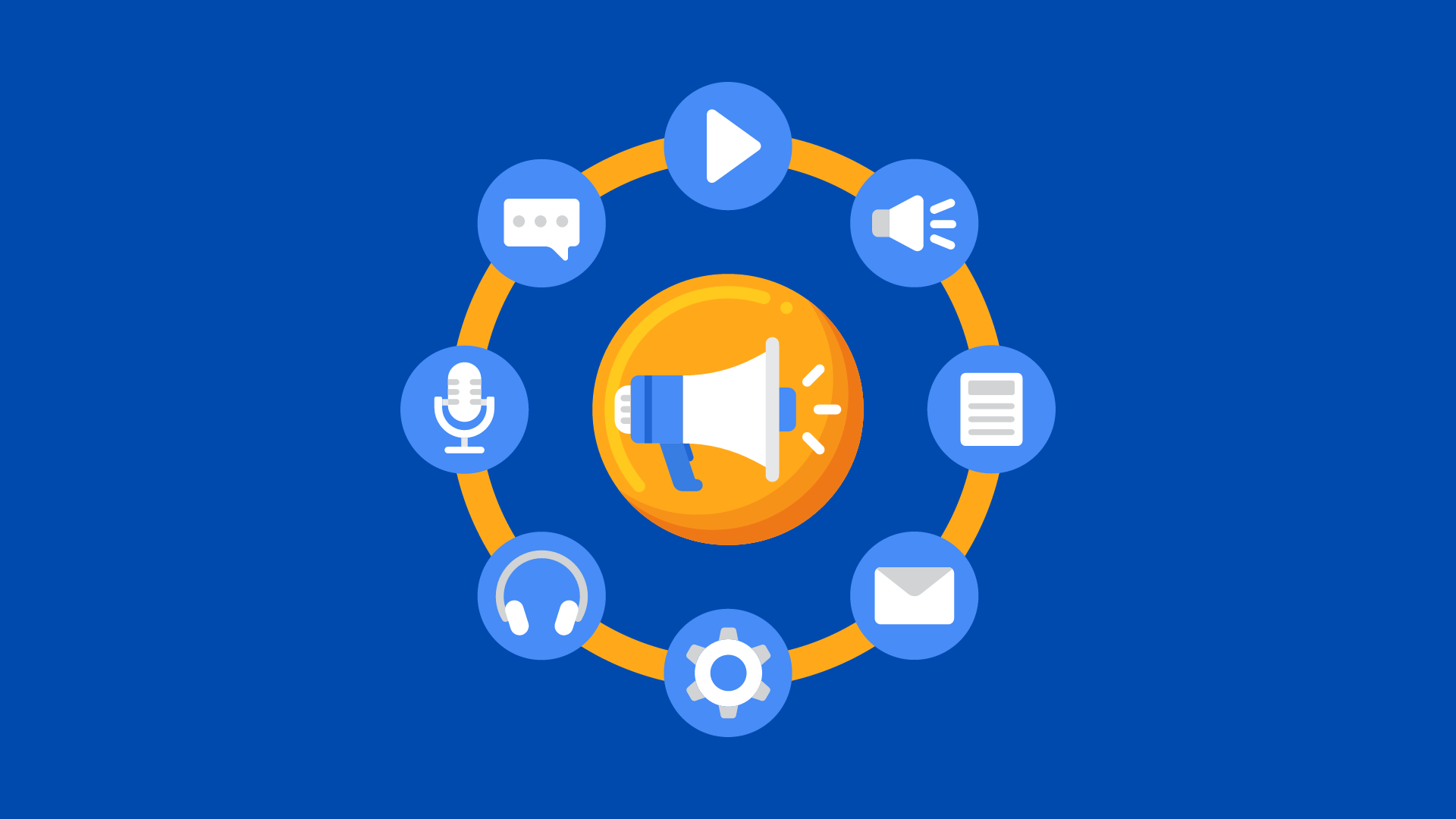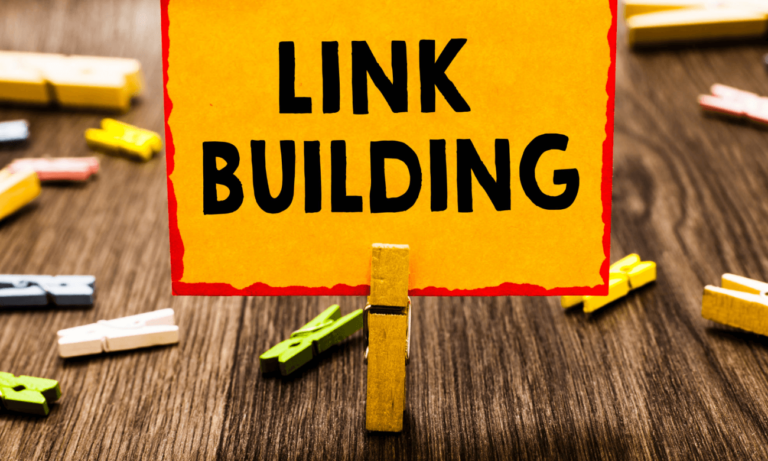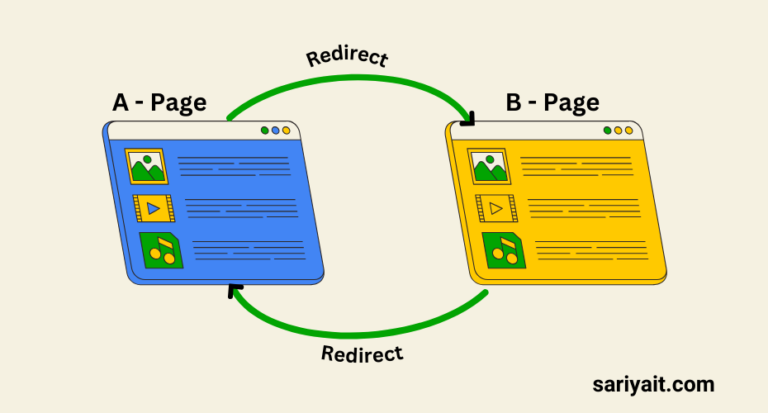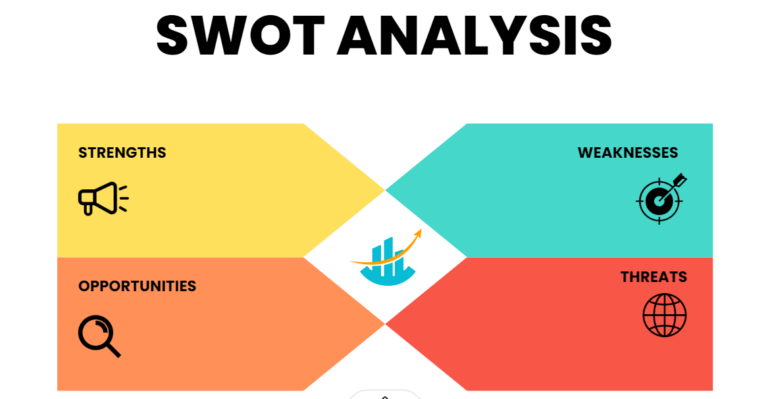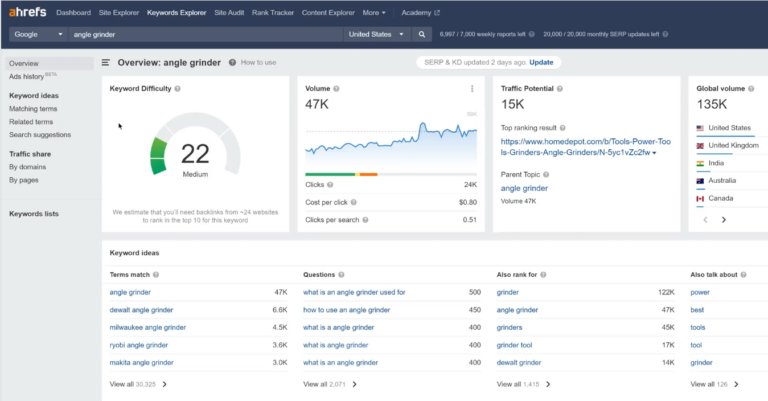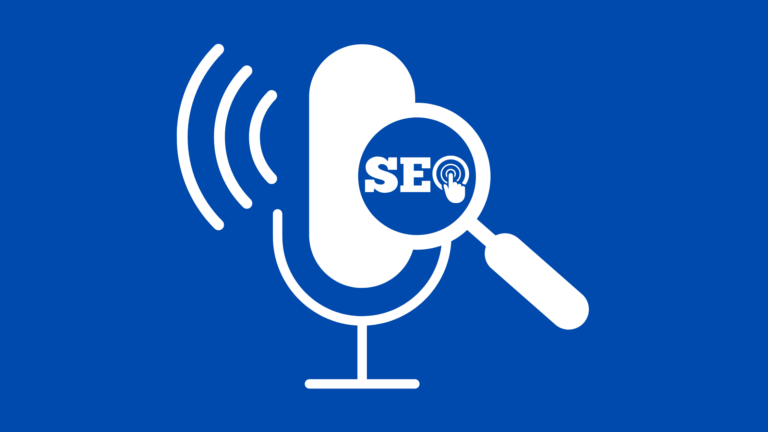We all naturally desire quick results, especially in the business world. The question is, how can we achieve significant results in business through the use of a digital marketing strategy? The answers become clear as you carefully read the following article.
Over 5.3 billion people worldwide use the internet. This staggering number represents an enormous pool of potential customers, making digital marketing an indispensable tool for businesses of all sizes. It’s not just about reaching a vast audience; it’s about connecting with them effectively through a powerful digital marketing solution.
Table of Contents
Understanding Immediate Results
Understanding the concept of immediate results is crucial. We’ll start by defining what immediate results mean in this context, and then we’ll explore why they hold such significant importance.
Defining Immediate Results in Digital Marketing
Immediate results in digital marketing refer to the rapid and tangible outcomes that a marketing strategy can produce within a relatively short time frame. These outcomes may include increased website traffic, higher conversion rates, a surge in social media engagement, or a boost in sales. Essentially, it’s about achieving measurable success quickly.
Why Immediate Results Matter
Immediate results in digital marketing are more than just a quick win; they are the lifeblood of modern businesses. Let’s take a closer look at why they are indispensable.
The attention span of potential customers is shrinking. Research shows that the average human attention span has decreased to less than 8.25 seconds. This means you have a very brief window to capture your audience’s attention and make a lasting impression.
Immediate results allow you to seize this fleeting opportunity. They enable you to make an impact on your audience swiftly, increasing brand recognition and potentially converting casual visitors into loyal customers.
Studies have demonstrated that a 1-second delay in page load time can lead to a 7% reduction in conversions. This emphasizes the importance of speed and immediacy in digital marketing.
Immediate results also matter because they provide valuable feedback. They let you know if your marketing strategy is on the right track or if adjustments are needed. Timely data and insights empower you to make informed decisions and optimize your approach, ensuring that your marketing efforts remain effective.
The need for immediate results is a business necessity. It’s about staying ahead of the competition, making a memorable impact, and adapting swiftly to an ever-evolving landscape. Understanding immediate results and their significance is the first step toward crafting a winning digital marketing strategy.
The MECE Framework in Digital Marketing
MECE stands for “Mutually Exclusive, Collectively Exhaustive,” and it’s not just a complex acronym; it’s a powerful tool for creating clear and effective strategies.
Imagine MECE as the building blocks of your marketing plan, where each piece fits perfectly without any gaps or overlaps. It’s like assembling a precise jigsaw puzzle to achieve your goals.
Relevance of MECE in Digital Marketing
Now, you might be wondering, why is this framework so important in the field of digital marketing.
The answer lies in the need for precision. In a world where information is abundant and attention spans are scarce, a well-structured marketing strategy is a game-changer. MECE ensures that every component of your strategy is unique and comprehensive, leaving no room for ambiguity.
To put it in perspective, consider a multinational corporation aiming to expand its online presence. By applying the MECE framework, they meticulously divided their target audience into distinct segments, each with tailored content and approaches.
Moreover, the MECE framework empowers you to make data-driven decisions. In digital marketing, data is gold, and without clear structures, it’s like searching for a needle in a haystack. By organizing your strategy MECE-style, you can easily identify what’s working and what’s not, ensuring that your efforts are always on point.
So, as you dive into the depths of digital marketing, remember that MECE isn’t just a fancy term; it’s the compass that guides you toward clear objectives, precision, and measurable success. Embrace it, and you’ll find your marketing strategies becoming sharper and more effective than ever before.
Key Elements of a Successful Digital Marketing Strategy
To reach your destination, you need a roadmap with clear directions. This roadmap is composed of five vital elements:
A. Clear Objectives
Every journey starts with a destination in mind, and the same goes for digital marketing. Set clear, measurable objectives to guide your efforts. It’s like deciding your final stop before embarking on a road trip.

B. Target Audience Identification
Knowing your audience is like understanding who your fellow travelers are. Create detailed buyer personas to grasp your audience’s needs, preferences, and pain points. This not only helps you tailor your marketing efforts but also makes your audience feel heard and valued.
C. Competitive Analysis
In a crowded marketplace, it’s essential to know who you’re competing against. Conduct a thorough competitive analysis to uncover your rivals’ strengths and weaknesses. It’s akin to scouting your fellow travelers to anticipate their moves.
D. Budget Allocation
Just as you plan your budget for a journey, allocate your digital marketing budget wisely. According to industry standards, B2C companies typically allocate between 5% and 10% of their revenue to marketing. Ensure your budget aligns with your objectives and the strategies required to achieve them.
E. Platform Selection
Choosing the right digital platforms is like selecting the right vehicles for your journey. Whether it’s social media, email marketing, or pay-per-click advertising, ensure your platforms resonate with your audience and objectives.
To illustrate, a local restaurant looking to increase its customer base might find that engaging with the community through social media platforms like Instagram and Facebook yields the best results.
In summary, these five elements form the foundation of a successful digital marketing strategy. By defining clear objectives, understanding your audience, assessing your competitors, allocating your budget effectively, and selecting the right platforms, you’ll be well-prepared for your digital marketing journey.
Immediate Results Strategies in Digital Marketing
When the need for immediate results arises in digital marketing, there’s an array of strategies at your disposal. Let’s explore these potent tools that can help you achieve your goals swiftly.
A. Pay-Per-Click (PPC) Advertising
Imagine placing your brand in front of your target audience precisely when they’re searching for your products or services. This is what PPC advertising does. It’s like paying for the toll booth to the express lane on the digital highway.
Statistics reveal that businesses make an average of $2 in revenue for every $1 they spend on Google Ads, making PPC a highly effective strategy.
B. Social Media Advertising
In a world where billions of people spend hours on social media platforms daily, it’s crucial to leverage this avenue. Social media advertising allows you to connect with your audience where they’re most active.
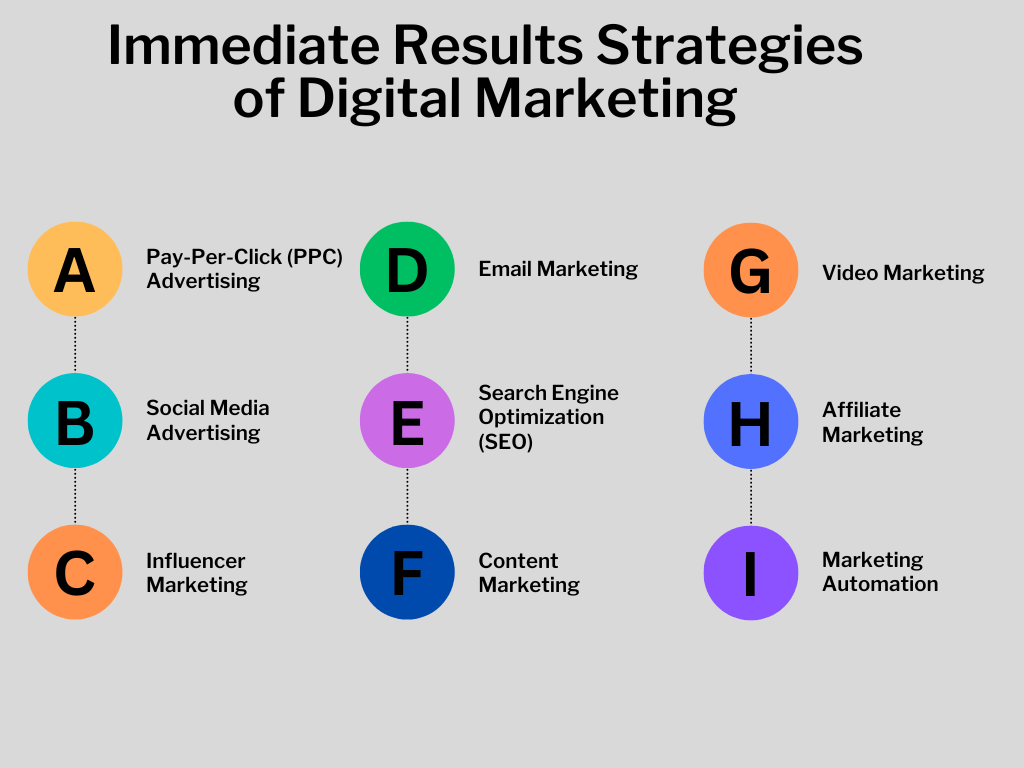
C. Influencer Marketing
Influence is a powerful force in the digital realm. Collaborating with influencers who have a substantial following in your niche can give your brand a significant boost. It’s akin to having someone recommend your journey to fellow travelers.
A study found that influencer marketing delivers 11 times higher ROI compared to traditional forms of digital marketing.
D. Email Marketing
The trusty email remains a stalwart in digital marketing. It’s like sending personalized postcards to your subscribers. A well-crafted email marketing campaign can yield impressive results.
Reports indicate that email marketing has an average ROI of 42:1, meaning you can potentially earn $42 for every $1 you invest.
E. Search Engine Optimization (SEO)
SEO is like ensuring that your journey is listed on every map. When your website is optimized for search engines, you can attract organic traffic and improve your online visibility.
Studies show that the first organic search result receives nearly 39.8% of all clicks, emphasizing the importance of SEO.
F. Content Marketing
Quality content is the heart of digital marketing. It’s like providing valuable travel tips to fellow explorers. Engaging content can attract and retain your audience, leading to immediate results.
Content marketing costs 62% less than traditional marketing and generates about three times as many leads.
G. Video Marketing
In a world where people love visual storytelling, video marketing is the way forward. It’s like showing your journey in action. With platforms like YouTube, you can engage with a massive audience.
Research suggests that 85% of businesses use video marketing, and 87% of marketing professionals use video as a marketing tool.
H. Affiliate Marketing
Imagine having a team of promoters who only get paid when they bring results. This is the essence of affiliate marketing. It’s a cost-effective way to expand your reach and achieve immediate results.
Amazon’s affiliate program is a prime example, generating significant revenue through commission-based marketing.
I. Marketing Automation
Efficiency is key in digital marketing. Marketing automation tools streamline your processes, ensuring that the right message reaches the right audience at the right time. It’s like having a digital assistant for your journey.
Statistics show that 80% of marketers saw an increase in leads after implementing marketing automation.
In a fast-paced digital world, these immediate results strategies serve as your trusty companions, offering you the means to reach your destination swiftly and effectively. By choosing the right combination of strategies for your specific objectives, you can navigate the digital landscape with confidence.
Advantages and Disadvantages of Digital Marketing Strategies
In the dynamic world of digital marketing, each strategy comes with its own set of pros and cons. Let’s explore the key aspects of each strategy to help you make informed decisions.
A. PPC Advertising Pros and Cons
Pros: Pay-Per-Click (PPC) advertising delivers rapid results. With proper targeting, you can reach your ideal audience precisely when they’re searching for your products or services.
Cons: It can be costly if not managed efficiently, and it requires continuous monitoring and adjustment.
B. Social Media Advertising Pros and Cons
Pros: Social media advertising provides a vast and engaged audience. It allows for precise targeting based on demographics, interests, and behaviors.
Cons: Managing multiple platforms can be time-consuming, and competition is fierce.
C. Influencer Marketing Pros and Cons
Pros: Influencers offer authentic endorsements, build trust, and reach niche audiences effectively.
Cons: Costs can be high, and it can be challenging to find the right influencer for your brand.
D. Email Marketing Pros and Cons
Pros: Email marketing has a high ROI and is excellent for building long-term relationships with customers.
Cons: It can be perceived as spam if not executed correctly, and open rates can vary.
E. SEO Pros and Cons
Pros: Search Engine Optimization (SEO) provides organic, sustainable results, and increases your website’s visibility in search engines.
Cons: It’s a long-term strategy, and algorithm changes can impact rankings.
F. Content Marketing Pros and Cons
Pros: Content marketing establishes your authority, attracts organic traffic, and engages your audience.
Cons: It requires consistent effort and may take time to yield substantial results.
G. Video Marketing Pros and Cons
Pros: Video marketing is highly engaging, ideal for storytelling, and can be shared across platforms.
Cons: It demands quality production and editing, which can be costly.
H. Affiliate Marketing Pros and Cons
Pros: Affiliate marketing can expand your reach through a network of promoters who earn commissions on results.
Cons: Managing a network of affiliates can be complex and requires supervision.
I. Marketing Automation Pros and Cons
Pros: Marketing automation streamlines repetitive tasks, nurtures leads, and provides valuable insights.
Cons: Initial setup can be complex, and it may lack the personal touch of human interaction.
For instance, a startup seeking rapid results might opt for PPC advertising to swiftly boost its online presence. However, they should be aware of the potential costs involved.
In contrast, a well-established brand aiming for long-term growth might lean towards content marketing and SEO to solidify their online authority. Each strategy comes with its unique strengths and challenges.
By understanding these pros and cons, you can choose the right mix to steer your digital marketing campaign toward success.
Crafting a MECE Strategy for Immediate Results
MECE strategy is the compass that can lead you to immediate success. Here’s how it’s done:
A. Combining Strategies for Immediate Results
Combining multiple digital marketing strategies is akin to having an assortment of tools in your toolkit. Each strategy has its unique strengths, and by integrating them, you can amplify your impact.
B. Aligning Strategies with Objectives
Just as a skilled navigator aligns the ship’s course with the destination, align your digital marketing strategies with your objectives. Ensure that each strategy contributes directly to your defined goals.
Suppose you’re a startup aiming to increase brand awareness. Content marketing, coupled with SEO, can be a powerful combination. A study revealed that businesses with blogs receive 67% more leads than those without.
C. Optimizing the Budget
Optimizing your budget is the equivalent of managing your resources efficiently during your journey. Allocate your budget to strategies based on their potential for immediate results.
By combining strategies, aligning them with your objectives, and optimizing your budget, you’re setting a course for immediate results. It’s like steering a ship through the digital waves, with each decision propelling you closer to your desired destination.
Measuring Immediate Results in Digital Marketing
Here’s how you measure and optimize those immediate results.
A. Key Performance Indicators (KPIs) for Success
Just as a captain relies on navigational tools, digital marketers depend on KPIs to gauge success. These performance indicators are the compass guiding your campaign.
For example, if you’re running a PPC campaign, KPIs might include click-through rates (CTR), conversion rates, and cost per conversion. These metrics reveal how well your strategy is performing.
B. Analyzing Data
Data analysis is the equivalent of scrutinizing a treasure map. Dive deep into the data generated by your digital marketing efforts. It’s like deciphering clues that lead you to buried treasure.
By examining data, you can discover valuable insights into audience behavior, campaign performance, and areas that require adjustment.
For instance, analyzing user behavior on your website can reveal which pages are most engaging and which need improvement.
C. Making Real-Time Adjustments
Real-time adjustments are the sail that steers your ship. React swiftly to the insights gained from data analysis.
For instance, if you notice a drop in engagement on your social media posts, it’s time to adapt. Change your content, posting schedule, or audience targeting to maintain the course towards immediate success.
Real-life examples underscore the significance of measuring immediate results. A fitness app company, after analyzing user data, noticed a significant drop-off rate after the first week of sign-ups.
By relying on KPIs, data analysis, and real-time adjustments, you can ensure that your journey leads to a treasure trove of immediate results.
The Role of Content in Digital Marketing
Content is the most important part of digital marketing. Here’s how it fuels your journey to success.
A. Content Creation and Optimization
Content creation, It’s about creating valuable, relevant, and engaging material that resonates with your audience. But, it’s not just about creating; it’s also about optimizing.
Research shows that content with relevant images gets 94% more views than content without. Optimizing content for search engines is equally vital. An aptly optimized blog post or webpage can rank higher in search results, increasing visibility.
B. The Content Calendar
A content calendar is your itinerary for the journey. It organizes your content creation and ensures consistency. A well-planned calendar can improve efficiency, maintain audience engagement, and align with business objectives.
For instance, a travel website that publishes content related to holiday destinations plans its content calendar around peak travel seasons. This foresight optimizes audience engagement.
C. Content Distribution
Distribution is equivalent to mapping out your journey’s route. Once you have your content ready, you need to ensure it reaches the right audience. Leveraging various distribution channels, including social media, email marketing, and paid promotions, is essential.
According to the 2023 State of Marketing Report by Hubspot, Facebook has emerged as the leading distribution channel, with 64% of marketers using it. Following Facebook, Instagram is the second most popular platform, used by 58% of marketers, while YouTube is close behind at 57%. X (Previous Name Twitter) is also a significant channel, with 43% of marketers utilizing it. Meanwhile, TikTok and LinkedIn are used by 42% and 33% of marketers, respectively.
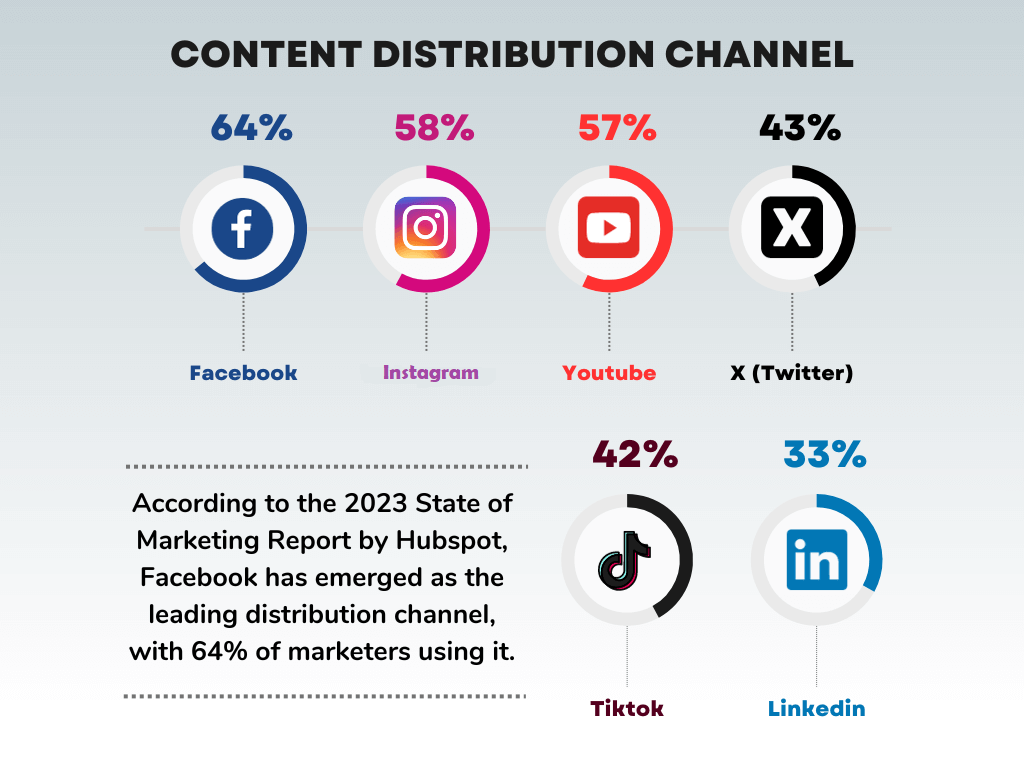
In summary, content is not just an element of digital marketing; it’s the essence. Content creation and optimization, a well-structured content calendar, and effective content distribution are the pillars of a successful campaign. They can set your digital marketing journey on the path to achieving remarkable results.
Staying Updated with Digital Marketing Trends
It’s not just a good idea but essential to keep up with the latest trends. Let’s explore why this is important and how you can ensure your marketing strategies remain at the forefront.
A. The Importance of Keeping Current
Imagine digital marketing trends as the winds that fill your sails on this journey. To stay ahead, you must catch the right wind at the right time.
The digital world changes at breakneck speed. For example, Google makes over 3,200 algorithm changes each year. Staying updated helps you adapt to these changes and harness them to your advantage.
B. Resources for Staying Informed
Resources for staying informed are like the compass that ensures you’re on the right course. Numerous outlets provide the latest updates on digital marketing trends, from industry publications to webinars, conferences, and online communities.
In conclusion, immediate success in digital marketing is achievable with a well-structured strategy, constant adaptation, and a keen eye on the horizon. By embracing these principles, you can set sail on a journey that leads to remarkable results in the ever-changing world of digital marketing.
